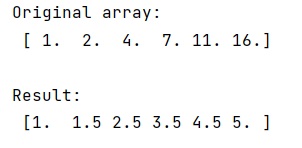Home »
Python »
Python Programs
What does numpy.gradient() do?
Learn about the Python's numpy.gradient() method, and how does it work?
By Pranit Sharma Last updated : December 28, 2023
NumPy is an abbreviated form of Numerical Python. It is used for different types of scientific operations in python. Numpy is a vast library in python which is used for almost every kind of scientific or mathematical operation. It is itself an array which is a collection of various methods and functions for processing the arrays.
Python numpy.gradient() Method
The numpy.gradient() method is used to find the gradient of an N-dimensional array. The gradient is computed using second-order accurate central differences in the interior points and either first or second-order accurate one-sides (forward or backward) differences at the boundaries. The returned gradient hence has the same shape as the input array.
numpy.gradient() Method Syntax
numpy.gradient(f, *varargs, axis=None, edge_order=1)
numpy.gradient() Method Parameter(s)
- f: array_like- An N-dimensional array containing samples of a scalar function.
- varargs: list of scalar or array, optional- Spacing between f values. Default unitary spacing for all dimensions. Spacing can be specified using:
- single scalar to specify a sample distance for all dimensions.
- N scalars to specify a constant sample distance for each dimension. i.e. dx, dy, dz, …
- N arrays to specify the coordinates of the values along each dimension of F. The length of the array must match the size of the corresponding dimension
- Any combination of N scalars/arrays with the meaning of 2. and 3.
- If axis is given, the number of varargs must equal the number of axes.
- edge_order: {1, 2}, optional- Gradient is calculated using N-th order accurate differences at the boundaries. Default: 1.
Let's understand with the help of an example,
Python code to demonstrate the example of numpy.gradient() method
# Import numpy
import numpy as np
# Creating a numpy array
arr = np.array([1, 2, 4, 7, 11, 16], dtype=float)
# Display original array
print("Original array:\n",arr,"\n")
# Finding gradient
res = np.gradient(arr)
# Display the result
print("Result:\n",res)
Output

In this example, we have used the following Python basic topics that you should learn:
Python NumPy Programs »